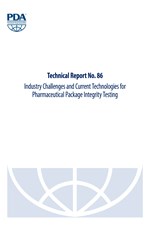Technical Report No. 86: Industry Challenges and Current Technologies for Pharmaceutical Package Integrity Testing
Premium Members: to claim your annual free technical document download, email membership@pda.org and indicate the document you wish to claim.
- Format
- PDF Single user
- Member Price
- $180.00
- Nonmember Price
- $325.00
- Government Price
- $180.00
Please sign in or become a member to purchase items from the PDA bookstore.
This technical report is a consensus-based resource surrounding the challenges encountered in using complex package systems and introduces important elements to consider in decision-making. It also offers an examination of the technologies available for package integrity testing not yet established by peer-reviewed research. This technical report focuses on the challenges facing the pharmaceutical industry that use complex packaging systems for sterile drugs and biologics (e.g., syringes, syringe assemblies, bulk containers). It also presents information on some innovative methods for package integrity testing using existing technologies, including the potential impact of cryogenic conditions. The intent is to update information and incorporate experiential learning which is not addressed in PDA Technical Report 27 and USP<1207>. It also serves as a technical resource, focusing particularly on sterile products and encouraging a risk-based approach and leveraging testing to better understand, analyze, and eliminate the risks during developmental phases. Use of the appropriate testing during each manufacturing phase can help in evaluating and mitigating residual risks.
Available to download. Prior to purchase please view the download instructions and Terms of Usage.
Format: PDF (1 file 2.22 MB)
*To purchase licensing, please contact PDA at info@pda.org.
Table of Contents
Table of Contents:
Click here to download >>> Detailed Table of Contents- Introduction
- Glossary
- Challenges with Methodologies
- Challenges with Package Design
- Innovative Methods for Existing Technologies
- Additional Considerations for Package Integrity Profiling
- Conclusion
- References
- Additional Reading
Figures and Tables Index
About the Authors
Tia Bush, Amgen (chair)
John Ayres, MD, Pharma Safety Solutions
Cecile Begat, Bayer
Antonio Burazer, Takeda
Fran DeGrazio, West Pharmaceutical Services
Carol Flynn, MEng, Corning
Abizer Harianawala, Stevanato Group
Paul Kinsey, GSK
Jahanvi Miller, MBA, PDA
Anthony Perry, Schott
John Shabushnig, Ph.D., Insight Pharma Consulting
Xu Song, MEng, Astra Zeneca
Hervé Soukiassian, MEng, BD
Andrew Spasoff, MS, Astra Zeneca
Amy Stanton, Amgen
Dorothee Streich, Ph.D., Bayer
Rick Watson, Merck
Elastomer Sub-team
Ravi Patel, West Pharmaceutical Services (Co- Chair)
John Rech, West Pharmaceutical Services (Co- Chair)
Andrea DeSalvia, Aptar
Wadi Farach, MEng, Amgen
Gert Gregoire, MBA, Datwyler
Lucia Ino, West Pharmaceutical Services
Denise Schnaufer, Merck
Larry Staub, MS, Quality Advisor
Julie Suman, Next Breath
Wadi Farach, MEng, Amgen
Rick Watson, Merck
Glass Sub-Team
Hervé Soukiassian, MEng, BD (Co-Chair)
Paul Kinsey, GSK (Co-Chair)
Alfred Breunig, Nipro Pharma Packaging
Benjamin Coutan, MBA, Gerresheimer
Wadi Farach, MEng, Amgen
Carol Flynn, MEng, Corning Incorporated
Martina Marchioro, Stevanato Group
Didier Morel, BD
Anthony Perry, Schott
Volker Rupertus, Schott AG
Daniele Zuccato, Schott AG

